#hammond public library
Text

Source: Jess Adams linktr.ee/jess.a.creates
#be kind#stay weird#books#booklr#booksareawesome#reading#hpl#reading is awesome#hammond public library#we love our library
20K notes
·
View notes
Text
Helpful hint for @hammondpubliclibrary patrons
You want to enjoy @hammondpubliclibrary ebooks, streaming movies and digital resources while we’re rebuilding, but your Library card is expired! What to do?
No problem! Just go to https://www.hammondlibrary.org/contact and fill out your name, email, and address. Then, in the space beneath, type a short note asking for a library card renewal. We’ll get you sorted out!
0 notes
Text
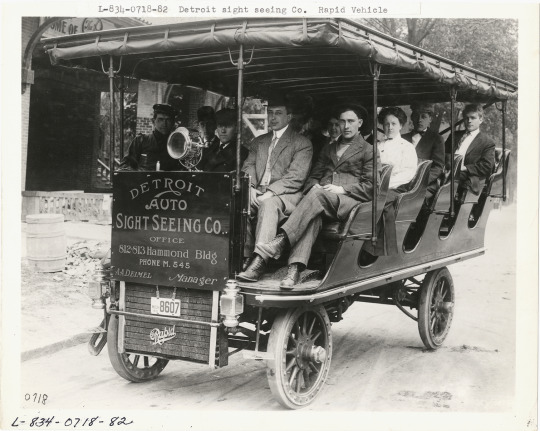
View of men and women in Rapid sightseeing bus. Sign on front of vehicle reads: "Detroit Auto Sight Seeing Co., office 812-813 Hammond Bldg., Phone M. 545, A.A. Deimel, manager." Typed on front: "Detroit Sight Seeing Co., Rapid vehicle." Handwritten on back: "Motor trucks--Rapid."
Lazarnick Collection
National Automotive History Collection, Detroit Public Library
#detroit auto sight seeing co#detroit#sight seeing#sightseeing#detroit history#rapid#deimel#vintage#detroit public library
30 notes
·
View notes
Text

The Lukasz Lyczkowski & 5 RANO Band Outdoor Concert on 24 June 2023 (phenomenal performance on the Sierakow music scene after the ceremonial opening of the Museum of Inland Fisheries and Water Protection at the Sierakow Public Library created in the rebuilt evangelical church). Rock&Roll is timeless and far from dead, still one of America's favorite music genre. The band’s classic hard rock, a Seattle-type musical culture from the grunge era (Jimi Hendrix, one of classic rock's most enduring guitar legends, was born and raised in Seattle) combined with modern sounds is a team rock performance based on charismatic vocals and powerful guitar riffs, the Hammond organ huge part in rock, and an excellent rhythm section (grunge drummer and guitbassist). The songs rooted in rock music from the 1960s and 1970s have been viewed over 23 million times on YouTube. The bandleader and vocalist Luke Lyczkowski has the best male voice of the 8th edition of The Voice Of Poland. The band has an official, superb Fan Club “Black Angels” present at the concert - marvelous contact with the audience. We had a fabulous time.
#the acclaimed#rock band#charismatic#concert#culturalheritage#evening star#excellent#famous#festive#favorite#good voice#grunge era#hard rock#wonderful#memorable moments#music#outdoor concert#professionalism#rock & roll#rock 'n' roll#rock music#rock show#fantastic#talented#world music
2 notes
·
View notes
Text
2023 Wrap up and 2024 Goals
So I have been keeping track of what books I've read and what games I've played each year, for many years now. It's actually been really fun and interesting to look back and see what I ended up with, and it helps when I have to reference when I last looked at something :D So! I'm gonna put my Book/Games list year and combine it with any goals for 2024
Things I've read since Jan 2023
The Written by Ben Galley
Ariel by Steven R Boyette (read most)
STNG: Grounded by David Bischoff
Ascendant by Michael R Miller
STNG: A Call to Darkness by Michael Jan Friedman
STNG: Metamorphosis by Jean Lorrah
Denver Moon: The Minds of Mars by Warren Hammond and Joshua Viola
Masters of Doom by David Kushner
Fourth Wing by Rebecca Yarros
The Horse Whisperer by Nicholas Evans
The Mountain in the Sea by Ray Nayler
The Tiger and the Wolf by Adrian Tchaikovsky
Untethered Sky by Fonda Lee
A Darker Shade of Magic by V.E. Schwab
This Gilded Abyss by Rebecca Thorne
Witch Hat Atelier 1-11 and Witch Hat Atelier Kitchen
All That Glitters by Loren K Jones
Comments: This is an example of like...I don't even remember reading some of these items. The STNG books (picked up from a library sale) were unexpectedly decent, I believe those were ones actually written by the show's screenwriters, so they read almost exactly like regular episodes. Also, I include manga (and some visual novels) on these lists because of the large quantities of reading ~ as such, WHA was probably my favorite read this year. The art is so gorgeous and the artistic struggles really resonates with me. My favorite non-manga waaas :Ta hmm, probably This Gilded Abyss, though I did not like the ending that much. Its fine if a book is going to be a series but I think that books should be able to be read as a one-off. I guess what I'm saying is make sure the ending is reasonably satisfying for THAT book, even if you want to set up for the next one. For example I'm well aware that ADSOM is a series however it's written with a satisfying ending that I can treat as Just One Book. Which I'm going to do. (Hopefully this all makes sense)
Currently Reading: Well my first book of the 2024 list is Heaven Official's Blessing 1, since its been on my shelf for a while ~ I'm already halfway through and just couldn't finish it before the new year. I see there's a ton in this series so IDK if I'll get through it all, but I do like it more (so far) over the other series by the same author
2024 Book Goals: I have a lot of unread ebooks so I'd like to start getting through those this year, as well as a couple paperback books on my shelf that have been there for years.
---
2023 Video Games:
Baba is You
Cats Organized Neatly
Resident Evil: Village
Ghost Song
Salamander County Public Television
Cassette Beasts
The Mortuary Assistant
Vampire Survivors
Cult of the Lamb
Milo and the Magpies
Pizza Tower
The Great Ace Attorney Chronicles (DNF)
Celeste (again)
Super Mario RPG remake
The Darkside Detective
The Darkside Detective: A Fumble in the Dark
Comments: Honorable mention is MyHouse.wad ~ I haven't played classic DOOM in so long and didn't want to learn how to mod it to play this, but I watched videos obsessively for several weeks when it came out. Its super cool. The Mortuary Assistant I found....strangely relaxing, I'm pretty sure this was not the common experience LOL. TGAAC made me kinda mad, I love AA but I COULD NOT with this one. I got 3 cases in, the pace was absolutely glacial and I did not like any of the side characters so I wasn't enjoying it. Oh well. My favorite game was probably either RE:V or collectively the two Darkside Detective games I just played.
Currently Playing: I just started Super Mario Wonder yesterday after getting it for Christmas. It's cute! I haven't played any mainline Mario games in like 10 years. Seriously the last ones were like Super Luigi Bros and Mario Maker 1 (and even then I think these are spinoffs 🤣)
2024 Game Goals: I have several games in my backlog that I would consider "Large RPGs", such as BG3, and I'd like to get through at least one of them. They're really daunting because of the time commitment required to finish. I'm currently working on some stupid grindy stuff in FFXIV so hopefully (lol) I will just take a break afterwards and can work on one of them.
---
Other 2024 Goals/Art Goals
Yeah I don't like to go too wild with goals anymore. 2023 was just a hot mess year in terms of my day job, for the entire year, and my brain got pretty scrambled. I couldn't think of any silly goal this year (I did "all Ghibli Movies" in a past year for example), so I'm gonna say:
Finish at least 1 sketchbook
Do/Post more finished pieces
Finish a piece of art I've had sitting on my desk since June 2022
I did a big consolidation of art supplies at the end of the year so hopefully I won't be so daunted by what to use in general. The ink challenge I did was very helpful getting a little bit of motivation back. I also have this piece of art that's been sitting unfinished on my desk for a year and a half and I really need to finish it, LOL. I think what happened is the lineart is pretty complicated - once I finished transferring it to a nice sheet of paper I got overwhelmed with the idea of 'ruining' it and put it aside. I really need to get it done though, however it turns out, and move on, as I think the lingering thought is blocking all other pieces.
#Yearly book list#Yearly games list#.txt#books#video games#new year goals#long post#this is a blog post
1 note
·
View note
Photo
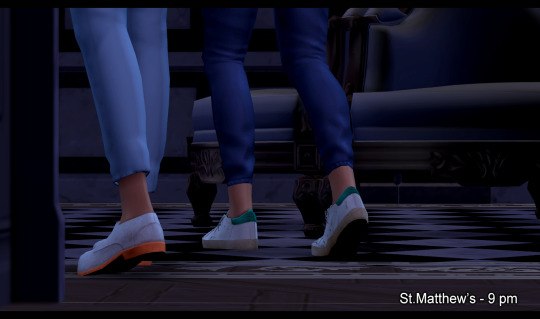
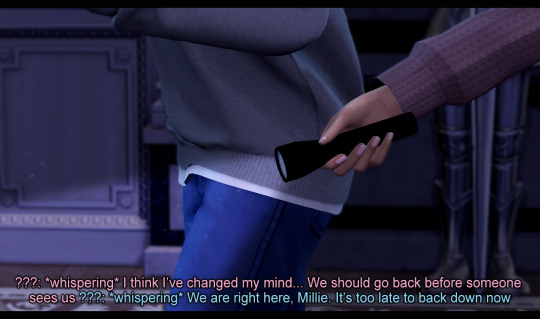
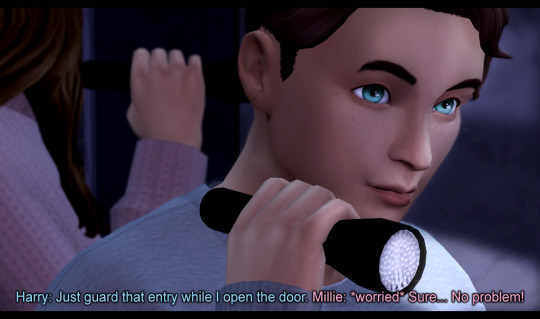

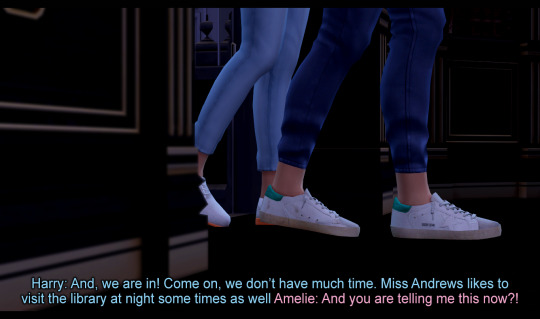
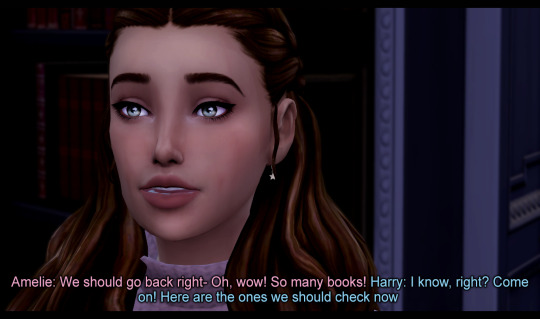
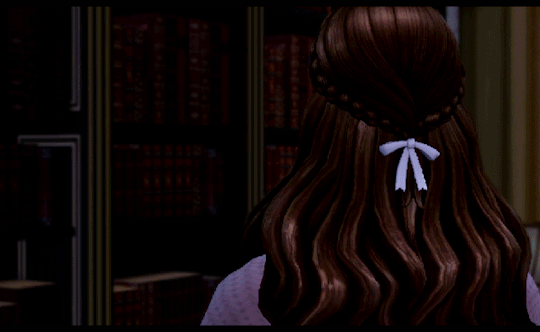
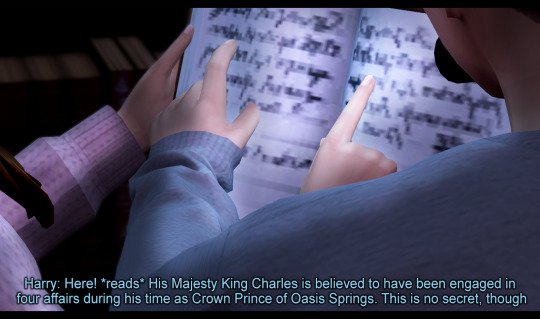
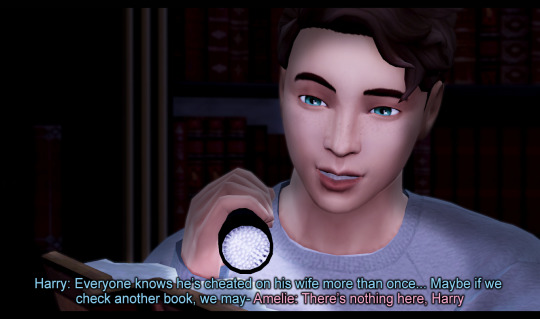


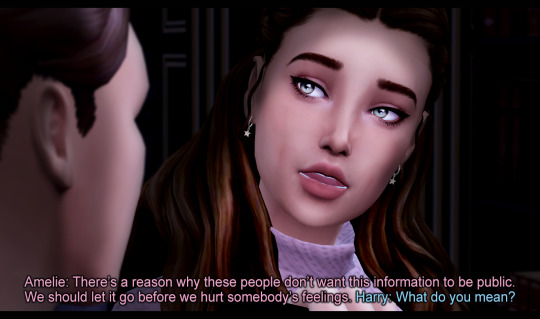
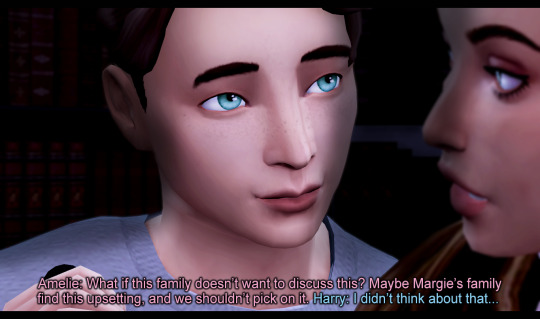



Transcript under the cut
Previous / Next
@thegrimalldis ♥
St.Matthew’s - 9 pm
???: *whispering* I think I’ve changed my mind... We should go back before someone sees us
???: *whispering* We are right here, Millie. It’s too late do back down now
Harry: Just guard the entry while I open the door
Amelie: *worried* Sure... No problem! Hurry up, Hammond!
Harry: Oh, Captain, my Captain! And, we are in! Come on, we don’t have much time. Miss Andrews likes to visit the library at night some times as well
Amelie: And you are telling me this now?! We should go back right- Oh, wow! So many books!
Harry: I know, right? Come one! Here are the ones we should check now
-------
Harry: Here! *reads* His Majesty King Charles is believed to have been engaged in four affairs during his time as Crown Prince of Oasis Springs. This is no secret, though. Everyone knows he’s cheated on his wife more than once... Maybe if we find another book, we may-
Amelie: There’s nothing here, Harry. It doesn’t say anything of his illegitimate children. See? *reads* King Charles has denied producing more children aside Their Royal Highnesses Princess Natalia and Prince Cristobal.
Harry: It has to be here! I swear he has more children than them! We should ask Margie. She has to know more about this
Amelie: I think we should leave it... There’s a reason why these people don’t want this information to be public. We should let it go before we hurt somebody’s feelings
Harry: What do you mean?
Amelie: What if this family doesn’t want to discuss this? Maybe Margie’s family finds this upsetting, and we shouldn’t pick on it.
Harry: I didn’t think about that...
Amelie: I think we should base our speech on the information we already have, and leave this business alone. Specially knowing that members of your family could get hurt, Harry
Harry: I’m pretty sure they know about this, but you are right. But you can’t deny this is a very interesting case!
Amelie: You are right on that! I wonder what he did to make them disappear so fast
???: What’s the meaning of this?!
#THL#The Hammond Legacy#the sims 4#ts4#sims4#the sims 4 legacy#the sims legacy#ts4gameplay#ts4legacy#ts4storytelling
40 notes
·
View notes
Note
Jurassic Park is a 1993 American science fiction action film[4] directed by Steven Spielberg and produced by Kathleen Kennedy and Gerald R. Molen. It is the first installment in the Jurassic Park franchise, and the first film in the Jurassic Park original trilogy, and is based on the 1990 novel of the same name by Michael Crichton and a screenplay written by Crichton and David Koepp. The film is set on the fictional island of Isla Nublar, located off Central America's Pacific Coast near Costa Rica. There, wealthy businessman John Hammond and a team of genetic scientists have created a wildlife park of de-extinct dinosaurs. When industrial sabotage leads to a catastrophic shutdown of the park's power facilities and security precautions, a small group of visitors and Hammond's grandchildren struggle to survive and escape the perilous island.
Before Crichton's novel was published, four studios put in bids for its film rights. With the backing of Universal Studios, Spielberg acquired the rights for $1.5 million before its publication in 1990; Crichton was hired for an additional $500,000 to adapt the novel for the screen. Koepp wrote the final draft, which left out much of the novel's exposition and violence and made numerous changes to the characters. Filming took place in California and Hawaii from August to November 1992, and post-production rolled until May 1993, supervised by Spielberg in Poland as he filmed Schindler's List. The dinosaurs were created with groundbreaking computer-generated imagery by Industrial Light & Magic (ILM) and with life-sized animatronic dinosaurs built by Stan Winston's team. To showcase the film's sound design, which included a mixture of various animal noises for the dinosaur roars, Spielberg invested in the creation of DTS, a company specializing in digital surround sound formats. The film also underwent an extensive $65 million marketing campaign, which included licensing deals with over 100 companies.
Jurassic Park premiered on June 9, 1993, at the Uptown Theater in Washington, D.C., and was released on June 11 in the United States. It went on to gross over $914 million worldwide in its original theatrical run,[5] becoming the highest-grossing film ever at the time, a record held until the release of Titanic in 1997.[6] It received positive reviews from critics, who praised its special effects and Spielberg's direction.[7] Following its 20th anniversary re-release in 2013, Jurassic Park became the oldest film in history to surpass $1 billion in ticket sales and the seventeenth overall. The film won more than twenty awards, including three Academy Awards for its technical achievements in visual effects and sound design. In 2018, it was selected for preservation in the United States National Film Registry by the Library of Congress as being "culturally, historically, or aesthetically significant". The film was followed by five sequels – The Lost World: Jurassic Park (1997), Jurassic Park III (2001), Jurassic World (2015), Jurassic World: Fallen Kingdom (2018), and Jurassic World Dominion (2022).
woag..... dinosaurs.......
4 notes
·
View notes
Text
New exhibits showcase trailblazing MIT women
New Post has been published on https://sunalei.org/news/new-exhibits-showcase-trailblazing-mit-women/
New exhibits showcase trailblazing MIT women

This spring, two new exhibits on campus are shining a light on the critical contributions of pathbreaking women at the Institute. They are part of MIT Libraries’ Women@MIT Archival Initiative in the Department of Distinctive Collections. Launched in 2017, the initiative not only adds to the historical record by collecting and preserving the papers of MIT-affiliated women, it shares their lives and work with global audiences through exhibits, multimedia projects, educational materials, and more.
Under the Lens
“Under the Lens: Women Biologists and Chemists at MIT 1865-2024,” examines the work of women in science and engineering at MIT beginning with Ellen Swallow Richards, the Institute’s first female student and instructor, through the present day, when a number of women with backgrounds in biology, biological engineering, chemistry, and chemical engineering — the subjects of focus in this exhibit — hold leadership positions at the Institute, including President Sally Kornbluth, Vice Provost for Faculty Paula Hammond, and Professor Amy Keating, who heads the Department of Biology.
Exhibit curator Thera Webb, Women@MIT project archivist, explains the exhibit title’s double meaning: “The women featured in ‘Under the Lens’ are scientists whose work engages with the materials of our world on a molecular level, using the lens of a microscope,” she says. “The title also plays on the fact that women’s ability to work as scientists and academics has been scrutinized through the lens of public opinion since Victorian-era debates about co-education.”
Items for the exhibit, selected from Distinctive Collections, demonstrate the experiences of women students, research staff, and faculty. They include the 1870 handwritten faculty meeting notes admitting Richards, then Ellen Henrietta Swallow, as MIT’s first female student, stating “the Faculty are of the opinion that the admission of women as special students is as yet in the nature of an experiment.” Materials from alumna and late professor ChoKyun Rha’s “Rheological Characterization of Printing Ink,” circa 1979, include images of the development process of ink and data from experiments. Also on display are a lab coat and rodent brain tissue slides from the neuroscience laboratory of Susan Hockfield, MIT’s 16th president.
“The collections we have related to women at MIT not only show us what their academic and professional interests were, with items like lab notebooks and drafts of papers, but also how our MIT community has been actively supporting women in science,” says Webb. “Many of our alumnae and faculty have been involved with the founding of groups like the Association of American University Women, the MIT Women’s Association, the Association for Women in Science, and the Women in Chemistry Group.”
“Under the Lens: Women Biologists and Chemists at MIT 1865-2024” is on view in the Maihaugen Gallery (Room 14N-130) through June 21. There is an accompanying digital exhibit available on the MIT Libraries’ website.
Sisters in Making
“Sisters in Making: Prototyping and the Feminine Resilience,” on view in Rotch Library, explores the unseen women, often referred to as “weavers,” who were instrumental to the development of computers. The exhibit, the work of Deborah Tsogbe SM ’23 and Soala Ajienka, a current architecture graduate student, spotlights the women who built the core rope memory and magnetic core memory for the Apollo Guidance Computer.
“While we ultimately know the names of the first men on the Moon, and of those who spearheaded the engineering initiatives behind the Apollo 11 mission, the names of the countless women who had a vital hand in realizing these feats have been missing from historical discourse,” Tsogbe and Ajienka write. “The focus of our work has been to uncover the names and faces of these women, who held important positions including overseeing communications, checking codes, running calculations, and weaving memory.”
Working in the archives, Tsogbe and Ajienka sought to identify the women involved in this endeavor, going through personnel logs, press releases, and other historical artifacts. Originally focused on the women working on rope memory, they broadened the scope of women involved in the journey to the moon and were able to name 534 women across 29 classes of work and nine organizations. Tsogbe and Ajienka fabricated a core memory prototype with the names of some of these women stored; they were technicians, data key punchers, engineers, librarians, and office staff from MIT, Raytheon, and NASA. Called the “memory dialer,” the prototype is intended to be a living archive.
Tsogbe and Ajienka created “Sisters in Making” as 2023 Women@MIT Fellows. This fellowship invites scholars, artists, and others to showcase materials from Distinctive Collections in engaging ways that contribute to greater understanding of the history of women at MIT and in STEM. The project also received a grant from the Council for the Arts at MIT.
“Deborah and Soala’s exhibit shows the variety of ways that the rich materials in the Women@MIT collections can be used,” says Webb. “Projects like these really highlight the value of historical collections in ways outside of traditional scholarly publications.”
“Sisters in Making: Prototyping and the Feminine Resilience” is on view in Rotch Library (Room 7-238) through April 8.
0 notes
Text
New exhibits showcase trailblazing MIT women
New Post has been published on https://thedigitalinsider.com/new-exhibits-showcase-trailblazing-mit-women/
New exhibits showcase trailblazing MIT women


This spring, two new exhibits on campus are shining a light on the critical contributions of pathbreaking women at the Institute. They are part of MIT Libraries’ Women@MIT Archival Initiative in the Department of Distinctive Collections. Launched in 2017, the initiative not only adds to the historical record by collecting and preserving the papers of MIT-affiliated women, it shares their lives and work with global audiences through exhibits, multimedia projects, educational materials, and more.
Under the Lens
“Under the Lens: Women Biologists and Chemists at MIT 1865-2024,” examines the work of women in science and engineering at MIT beginning with Ellen Swallow Richards, the Institute’s first female student and instructor, through the present day, when a number of women with backgrounds in biology, biological engineering, chemistry, and chemical engineering — the subjects of focus in this exhibit — hold leadership positions at the Institute, including President Sally Kornbluth, Vice Provost for Faculty Paula Hammond, and Professor Amy Keating, who heads the Department of Biology.
Exhibit curator Thera Webb, Women@MIT project archivist, explains the exhibit title’s double meaning: “The women featured in ‘Under the Lens’ are scientists whose work engages with the materials of our world on a molecular level, using the lens of a microscope,” she says. “The title also plays on the fact that women’s ability to work as scientists and academics has been scrutinized through the lens of public opinion since Victorian-era debates about co-education.”
Items for the exhibit, selected from Distinctive Collections, demonstrate the experiences of women students, research staff, and faculty. They include the 1870 handwritten faculty meeting notes admitting Richards, then Ellen Henrietta Swallow, as MIT’s first female student, stating “the Faculty are of the opinion that the admission of women as special students is as yet in the nature of an experiment.” Materials from alumna and late professor ChoKyun Rha’s “Rheological Characterization of Printing Ink,” circa 1979, include images of the development process of ink and data from experiments. Also on display are a lab coat and rodent brain tissue slides from the neuroscience laboratory of Susan Hockfield, MIT’s 16th president.
“The collections we have related to women at MIT not only show us what their academic and professional interests were, with items like lab notebooks and drafts of papers, but also how our MIT community has been actively supporting women in science,” says Webb. “Many of our alumnae and faculty have been involved with the founding of groups like the Association of American University Women, the MIT Women’s Association, the Association for Women in Science, and the Women in Chemistry Group.”
“Under the Lens: Women Biologists and Chemists at MIT 1865-2024” is on view in the Maihaugen Gallery (Room 14N-130) through June 21. There is an accompanying digital exhibit available on the MIT Libraries’ website.
Sisters in Making
“Sisters in Making: Prototyping and the Feminine Resilience,” on view in Rotch Library, explores the unseen women, often referred to as “weavers,” who were instrumental to the development of computers. The exhibit, the work of Deborah Tsogbe SM ’23 and Soala Ajienka, a current architecture graduate student, spotlights the women who built the core rope memory and magnetic core memory for the Apollo Guidance Computer.
“While we ultimately know the names of the first men on the Moon, and of those who spearheaded the engineering initiatives behind the Apollo 11 mission, the names of the countless women who had a vital hand in realizing these feats have been missing from historical discourse,” Tsogbe and Ajienka write. “The focus of our work has been to uncover the names and faces of these women, who held important positions including overseeing communications, checking codes, running calculations, and weaving memory.”
Working in the archives, Tsogbe and Ajienka sought to identify the women involved in this endeavor, going through personnel logs, press releases, and other historical artifacts. Originally focused on the women working on rope memory, they broadened the scope of women involved in the journey to the moon and were able to name 534 women across 29 classes of work and nine organizations. Tsogbe and Ajienka fabricated a core memory prototype with the names of some of these women stored; they were technicians, data key punchers, engineers, librarians, and office staff from MIT, Raytheon, and NASA. Called the “memory dialer,” the prototype is intended to be a living archive.
Tsogbe and Ajienka created “Sisters in Making” as 2023 Women@MIT Fellows. This fellowship invites scholars, artists, and others to showcase materials from Distinctive Collections in engaging ways that contribute to greater understanding of the history of women at MIT and in STEM. The project also received a grant from the Council for the Arts at MIT.
“Deborah and Soala’s exhibit shows the variety of ways that the rich materials in the Women@MIT collections can be used,” says Webb. “Projects like these really highlight the value of historical collections in ways outside of traditional scholarly publications.”
“Sisters in Making: Prototyping and the Feminine Resilience” is on view in Rotch Library (Room 7-238) through April 8.
#2023#2024#apollo 11#architecture#artists#Arts#Biological engineering#Biology#Brain#chemical#Chemical engineering#chemistry#classes#Collections#communications#Community#computer#computers#data#development#display#Diversity and Inclusion#double#education#engineering#engineers#Exhibits#Faculty#Featured#Global
0 notes
Text
The death of John R. Mills and RBM I's early life
As I noted in an earlier post on here, reprinting Goss's biography of RBM I, he writes that RBM I was "a native of New York state, born at Lake George, on the 20th of April, 1864 [1862], a son of John R. and Margaret (Bibby) Mills. The father was a miller by trade and engaged in his business for a number of years at Minerva, New York. He died in 1874 [1876], when his son Robert was ten [14] years old." Even the death at 10 years old must have been a tragedy (and dilemma) for RBM I. This is especially the case since, according to Goss's biography,
In the public schools of his native state Robert B. Mills secured his preliminary education. He passed his boyhood and youth upon a farm and as he approached maturity applied himself to the butcher's trade, in which he became proficient. When he was about twenty-one years of age [1883] he secured employment at Hotel Bennett, Binghamton, New York, as steward, a position which he held for ten years [1893].
Perhaps RBM I got by with his farm skills and as a butcher. He first appears in the 1865 census, showing his father John R. Mills as the head of household, living in Chester, Warren County, New York, with his mother Margaret, and 9 other siblings: Hattie B., Dora A., Margaret E., Mary J., Thomas, Joseph T., John C., Edward, and William. RBM I's age of 2 1/2 is relatively accurate in that he was born in 1862.
This post was originally published on WordPress in August 2018.
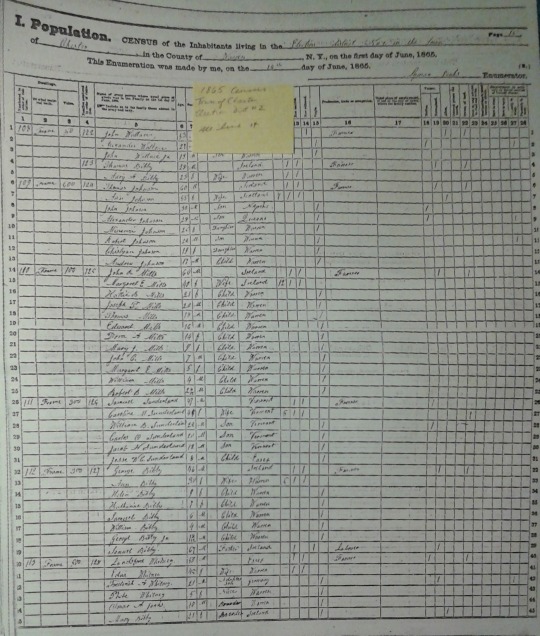
1865 census printout via the Warren County clerk
In 1870, Robert is still residing with the family, with his father John still a farmer, his brother Edward a farm laborer, his sister Dora a teacher, his mother Margaret at home, along with four of his other siblings: Willie, Maggie, John C., and Mary. There are also three borders: Hannibal Hammond (age 31, a carpenter), Hattie Hammond (age 25, Keep house), and Phebe Bibby (10 months, at home). Hannibal was the husband of Hetabella Mills, who is the same as Hattie Hammond. Phebe Bibby would be, by extension, an adopted child since it has a different last name. It says Robert is age 5, but he was born in 1862, so he is actually 8. The census is shown below:
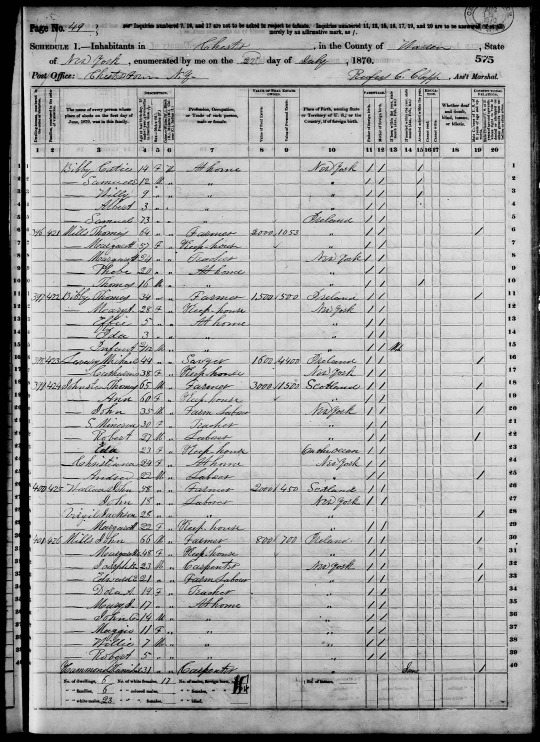
"United States Census, 1870," database with images, FamilySearch, John Mills, New York, United States; citing p. 49, family 426, NARA microfilm publication M593 (Washington D.C.: National Archives and Records Administration, n.d.); FHL microfilm 552,608.

However, by 1875, Robert, who would have been 13 at the time, was not in the household of John R. Mills (last household on the page), which was in Chester. This was after Margaret had died the previous year, hence why she is not in the census:

1875 census printout via Warren County clerk
Perhaps RBM I did go to "public schools" but it isn't indicated as such on the census. It is also probable that he "passed his boyhood and youth upon a farm." The same is the case about claim that he "applied himself to the butcher's trade." Looking through the census documents, one finds a Robert Mills, age 13, as the brother of the head of the household, living in Schroon, Essex, New York, which is about 12 miles northeast of Chester:

"New York State Census, 1875," database with images, FamilySearch, Robert Mills, Schroon, Essex, New York, United States; citing p. 7, line 4, State Library, Albany; FHL microfilm 866,322.
I am going to call it and say this is RBM I because in 1870, Edward E. Mills was age 21, and here in 1875 he is age 27. While the ages don't completely line up, I know for certain that Edna married Edward. It is not known why RBM I was not with his father and the rest of his cousins there. Anyway, he is listed here as single.
This means that the Robert Mills whom is a pauper in Bath, Steuben, New York is not him.
With this, it means that the Robert Mills in Schroon, Essex, New York in 1880, whom is a laborer, is RBM I. He is 17, single, and in the household of 75-year-old Ira Whitney. It is not known how he is related (if at all) to this individual.
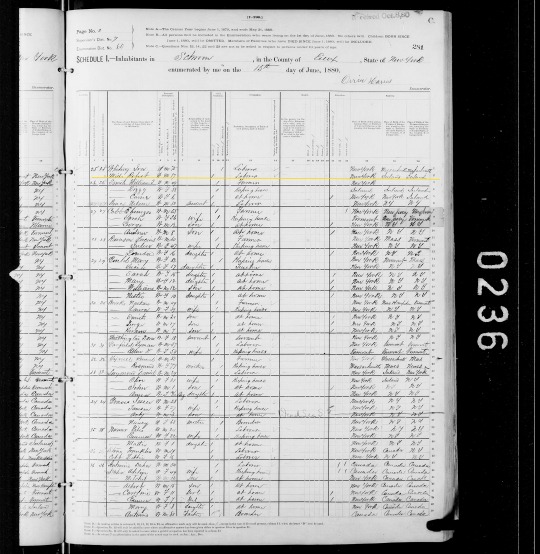
"United States Census, 1880," database with images, FamilySearch, Robert Mills in household of Ira Whitney, Schroon, Essex, New York, United States; citing enumeration district ED 60, sheet 281C, NARA microfilm publication T9 (Washington D.C.: National Archives and Records Administration, n.d.), roll 0833; FHL microfilm 1,254,833.
We do know, if Goss is right, that from 1883 to 1893 he worked at the Hotel Bennett in Binghamton, New York, about 162 miles (northeast) of Schroon, as a steward. We also know that he was listed as a steward, living in Binghamton, in 1892, as discussed in an earlier post (The story of Hattie Ellen Sterling). That may be just about the time that Hattie Ellen Stanley met RBM I. After all, they married on November 20, 1894, likely in New York.
© 2018-2023 Burkely Hermann. All rights reserved.
#family history#genealogy#family#ancestry#mills family#ancestors#mills#farmers#butchers#binghamton#hotels#new york state#warren county#new york#census#wordpress#19th century#1860s#1870s#schroon#chester new york#adirondacks
0 notes
Text
Letters to Santa at the Downtown Arlington Post Office
Details. Downtown Arlington has partnered with the Arlington Public Library and the United States Postal Service so you can write a letter to ...
Las Vegas Nevada Las Vegas NV Dover Delaware Dover DE
February 05, 2023 at 04:49AM
Hammond Louisiana Ukiah California Dike Iowa Maryville Missouri Secretary Maryland Winchester Illinois Kinsey Alabama Edmundson Missouri Stevens Village Alaska Haymarket Virginia Newington Virginia Edwards Missouri
https://unitedstatesvirtualmail.blogspot.com/2023/02/letters-to-santa-at-downtown-arlington.html
February 07, 2023 at 06:04AM
Gruver Texas Glens Fork Kentucky Fork South Carolina Astoria Oregon Lac La Belle Wisconsin Pomfret Center Connecticut Nason Illinois Roan Mountain Tennessee
https://coloradovirtualmail.blogspot.com/2023/02/letters-to-santa-at-downtown-arlington.html
February 07, 2023 at 08:42AM
from https://youtu.be/GuUaaPaTlyY
February 07, 2023 at 08:49AM
0 notes
Text
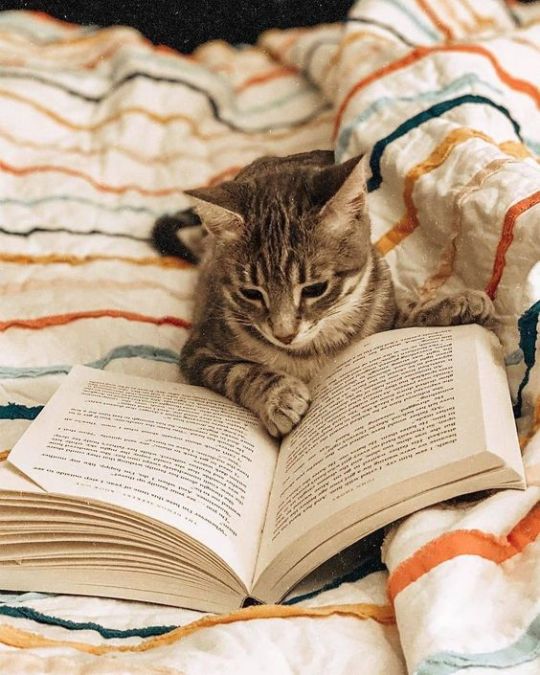
#books and cats#books#booklr#booksareawesome#reading#hpl#reading is awesome#hammond public library#we love our library
1K notes
·
View notes
Text
10 pastors wanted LGBTQ Pride Month displays banned at local libraries
Amid a contentious debate over recognition of LGBTQ Pride Month in Arlington, Texas, 10 area pastors sent an email urging the city’s mayor and city council to ban Pride displays at public libraries.
“We are asking that those displays not be allowed in our city library,” reads the August 24 email received by Mayor Jim Ross (I) and members of the Arlington city council, whose subject line read, “For your eyes only – Request for dialogue – Gay Pride Display directed toward children.”
“They do not align with the family and faith values of the majority of parents in Arlington and are actually designed to influence children into that lifestyle.”
In reality, a survey conducted by the library found that of the 1,800 responses, 1,062 did not support restrictions on Pride displays.
The email requested a meeting with Ross and the city council to discuss the displays. However, according to KERA News, the pastors were told they could not meet with the entire city council at once as doing so would require a public meeting.
“To be clear, we are not interested in creating a public spectacle, nor are we interested in standing against the LGBTQIA+ community,” the email continues. “Our aim in this requested conversation is to guard our community against sexually explicit and suggestive literature that is openly displayed in our public libraries directed toward the children/teens of this city.”
The email was co-signed by Gary Hutchison of Grace Community Church; Maurice Pugh of New Life Fellowship; Richard Martinez of Iglesia Cafe; Dennis Wiles of First Baptist Church Arlington; Marty Collier of Rush Creek; Ronnie Goines of Koinonia Christian Church; Jason Paredes of Fielder Church; Jeff Hubbard of North Davis Church of Christ; Stephen Hammond of Mosaic Church; and Eric Herrstrom of Lake Church.
Former Arlington Mayor Jeff Williams (R) issued Pride Month proclamations in 2020 and 2021. Ross, the city’s current mayor, did so again this year, drawing criticism from anti-LGBTQ speakers at city council meetings and calls to ban LGBTQ books from libraries.
Following a September 7 meeting between Ross, City Manager Try Yelverton, Director of Libraries Norma Zuniga, and seven of the pastors who co-signed the email, Gary Hutchison of Grace Community Church told the library advisory board that he and other pastors were concerned that identifying as a part of the LGBTQ community sends children on a “path to pain.”
“Some of it is caused because they’re not accepted and included in love and that’s horrible, but some of it is caused just because they’re going down that path,” Hutchison said.
On October 27, Arlington’s library advisory board approved a new policy that would restrict Pride Month displays to the adult and young adult sections while also creating permanent spaces for age-appropriate LGBTQ books in each section of the library. http://dlvr.it/SdW2yb
0 notes
Text
A break well-deserved

Through a quick search I did on newspapers.com today.
Note: This was originally posted on Feb. 21, 2019 on the main Packed with Packards WordPress blog (it can also be found on the Wayback Machine here).
As it stands now, this will be post 70 on this blog. Due to school commitments and other strains, the posts on this blog may be more irregular. The posts up to this point were written in a flurry in the summer and fall of last year when I had more time on my hands, meaning that they were queued. However, I still think there is good content on here that deserves to be read, including my last post on my grandfather Bob's sentimental journey to Massachusetts in 1980, a year before he sadly died of brain cancer at the age of 56. I will also note there is undoubted cross-over between this blog and Milling 'round Ireland, where I specifically focus on my Irish ancestry, with upcoming posts focusing on the ornate clothes of Dora Mills (Cyrus Packard's second wife), the burial spot of John Mills (the father of Dora), and the story of two other more distant ancestors, Henry Church and Mary Hammond. While I am still waiting to hear back about the status of the revived Packard's Progress, which I contributed an article for, and I will let all of you know, promoting it on this blog once it has been published.
I wish I could have contributed more insights on genealogy from an introduction to genealogy class I was supposed to take in January, taught by an archivist and librarian named Mary K. Mannix, whom has worked at Frederick County (Maryland) Public Libraries for almost the last 21 years and whom is apparently well-regarded in the genealogy community of which I am a part of.
With that, I will sign off and hope for the best in the days to come.
© 2019-2022 Burkely Hermann. All rights reserved.
0 notes
Photo
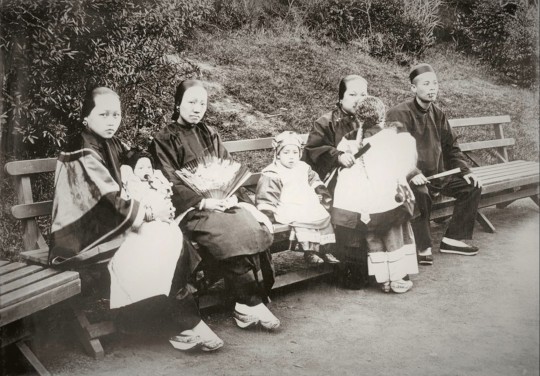
“Golden Gate Park. 1890s.” Photographer unknown (from the collection of the Bancroft Library).
Early Chinese Visitors in Golden Gate Park and Scenes From The Midwinter Fair
San Francisco’s Golden Gate Park represents the crown jewel of the city’s system of park and recreational spaces. Created on 1,013 acres of sand dunes in an unincorporated area of the Peninsula, known as the Outside Lands, and surveyor, designer, and future first Superintendent William Hammond Hall obtained the award of the project in 1870. Construction work commenced in 1871. The current acreage stands at 1,017 acres. (For a concise summary of the park’s creation and early photos by blogger “Doc B,” go here: https://thethirdself.com/2020/01/18/the-early-history-of-golden-gate-park/)
Since its inception, the life of Golden Gate Park even into this century has been marked by the tension between its founding as an urban public park for all and the impulse by segments of that public to allocate areas of the park for their specialized pursuits, uses, and monuments such as children’s playground, equestrian, archery, boating, museum, music, or lawn bowling. A subtitle for the history of the park could easily be posed as a question: “whose park?”
With a very few exceptions, the Gilded Age photos of the park’s patrons during its first 35 years of existence remain remarkable for their omission of at least 16 percent of San Francisco’s population – the Chinese. The photographic record is practically devoid of images of the City’s Chinese residents using the park.
As the above photo of a family in Golden Gate Park from the 1890s attests, the City’s first Chinese residents enjoyed the park. However, such daytime leisurely pursuits, which presumably included transportation to the western half of the City either by horse-drawn cart or cable car, would have been the privilege of a merchant’s household during the 19th century. The Bancroft collection’s striking photo captured not only a very rare instance of a Chinese family in the park but also the social standing of a fan-carrying, male head of household; he appears to have been accompanied by a young wife, probably his mother, and either a maid or an aunt of the three children shown in the photo.

“Chinese Women in Golden Gate Park, San Francisco, Feb. 22, 1900.” Photographer unknown (from opensfhisotry.org and courtesy of a private collector)
This photo of Chinese women, walking with fans on what may have been Golden Gate Park’s Main (now known as JFK) Drive, implicitly conveys the relative security of the unequal peace between whites and Chinese by the 1890s. By the start of the decade, the Chinese Exclusion Act of 1882 and a network of other laws and policies that reduced and compressed in urban enclaves most of the Chinese American population in California. The resulting smaller population, with its dwindling labor force, no longer posed a threat to white dominance of industry and trades on the urban frontier. Thus, even the “noble” women of Chinatown could travel to San Francisco’s Outside Lands and Golden Gate Park without fear of violence or other hindrance.
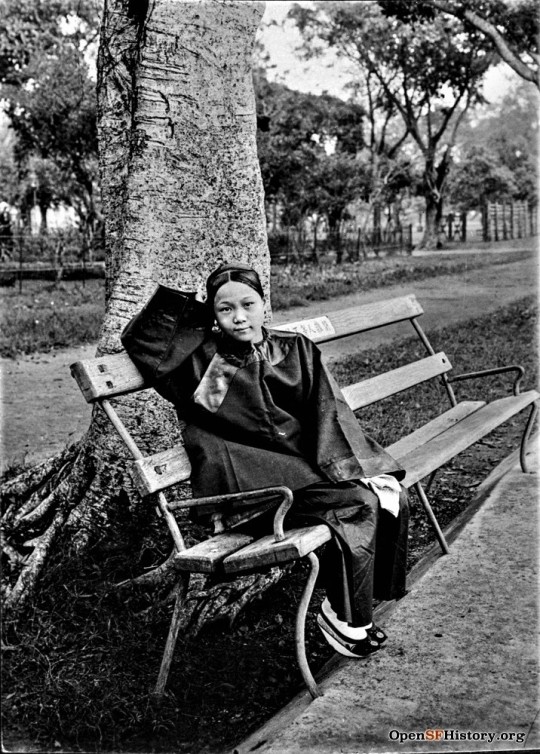
Chinese girl on a park bench, c. 1890s. Photographer and location unknown from the Marilyn Blaisdell collection.
The role of the Chinese in the first two decades’ history of Golden Gate Park, if any, remains unknown or at least unclear. Online resources only offer these few tantalizing images of San Francisco’s Chinese use of the park. Research continues.

A Chinese man walking toward three other Chinese in Golden Gate Park, c. 1900. Photographer unknown (from the Marilyn Blaisdell collection). The man is walking north between benches towards the old Memorial Museum and along the western side of the Music Concourse. The rear of the “Gladiator Statue” (of Spartan King Leonidas) by Willem Geefs appears at the center-left of the photo.
Chinese Go To The 1894 Midwinter Fair
The California Midwinter International Exposition of 1894, the first world’s fair held in the U.S. west of the Mississippi, offered 2 million visitors a glimpse of things to come in its 180 structures set on 160 acres. The Midwinter Fair, which was held in San Francisco’s Golden Gate Park from January 27 to July 4, 1894, used the grounds occupied the park’s area known today as the Music Concourse. Barbara Berglund’s fine and concise essay about this “Orientalist Exposition” envisioned by San Francisco Chronicle publisher Michael H. de Young may be read here.
From a Chinese American perspective, the Midwinter Fair provided the first significant grouping of photographs of Chinese participation in park activities and the opportunity presented by fair for the community to present a less-threatening image to the general public as embodied in the fair’s “Chinese Building.”

“8122 Chinese Building, Midwinter Fair, 1894. Photograph by Isaiah West Taber (from the Marilyn Blaisdell Collection). The Golden Gate Park’s powerhouse smokestacks appear at left.
Berglund quotes contemporary observations about the building as follows:
“The Chinese Building, designed by a local architectural firm and financed by the city’s Chinese merchants allowed visitors to view and possibly purchase ‘the deft handiwork of Chinese artisans and the wonderful products of Chinese ingenuity’ and provided ‘a curious and instructive object-lesson of the architectural ability of the inhabitants of the great Empire of the East.’”
Although not apparent at the time, the merchant community’s commission to a white architectural firm foreshadowed the strategy that Chinese merchants would use to rebuild Chinatown after the disaster of 1906. Taking a cue from the Midwinter Fair, Chinatown would be reconstructed into the tourist-serving “Oriental City” which would serve as the architectural economic template for diaspora communities around North America and beyond. Berglund correctly perceived the following promotional benefits of Chinese participation in the Midwinter Fair.”
“But the positive associations that could be derived from the Chinese Building about the achievements of Chinese culture were tempered by negative associations with Chinatown. Since the Chinese Building contained a restaurant, tea house, joss house, theater, and bazaar it not only replicated many of the standard sites of Chinatown’s tourist terrain but also the racializing work done by them. The fair’s promotional literature even told visitors that all of the ‘attractive features’ of Chinatown could be seen at the exposition’s Chinese Village ‘under much pleasanter conditions’—thus playing on prevailing stereotypes of the neighborhood as filthy, malodorous, and teeming and conjuring up unfavorable images of Chinese immigrants willing to live in such an environment.’”
As for the Chinese community itself, Berglund writes as follows:
“On the day that the Chinese Building opened, a Chronicle report related, “The Chinese themselves took a huge interest in the exhibit and the place was thronged all day.” This account noted that the merchants and tourist entrepreneurs “in charge” were “mightily proud of their building.” They “conducted visitors to the joss house,” while in the “reception room” a “cultured Chinese … explained the hidden meaning of the wondrous works of art which adorned the walls.” These men aided and abetted the Midwinter Fair’s Orientalist fantasy by presenting an image of the Orient that, to non-Asian visitors, likely came across as reinforcing the difference, strangeness, and barbarism of people of Asian descent. However they also created a space that San Francisco’s Chinese could participate in and succeeded in representing Chinese culture in ways that this local community could respond to with enthusiasm and pride.”
This more subtle civic engagement agenda, whether intentional or subconscious, can be seen in the some of the photographs of Chinese participants at the fair, particularly in the juxtaposition of the US flag with Chinese imagery as in this photo of a horse-drawn float with a dragon prow.

Golden Gate Park. China Day at the Midwinter Fair Jun 1894
A large dragon boat float in Chinese motif, flying American flags and pulled by horses. (Photographer unknown from the Wyland Stanley Collection)

“8484 Chinese Day at Midwinter Fair” June 1894. Photograph by Isaiah West Taber (from the Marilyn Blaisdell Collection). Children from San Francisco’s Chinese Public School form up in Golden Gate Park for China Day at the 1894 Midwinter Fair.

Children from San Francisco’s Chinese Public School line up in Golden Gate Park for China Day at the 1894 Midwinter Fair. Photographer unknown (from the collection of the San Francisco Public Library).
The deployment of Chinese children from Chinatown in citywide events served the new, benign narrative. The student-participants from the segregated Chinese Public School carried American flags conveyed patriotic sentiments and also a sense of poignancy. By 1894, the exclusion of Chinese from the US had been made permanent with the Geary Act of 1892, and the Chinese Six Companies-led boycott of the federal law’s residency certificate scheme had collapsed miserably in the preceding year after the US Supreme Court’s decision in Fong Yue Ting v. United States, 149 US 698 (1893).
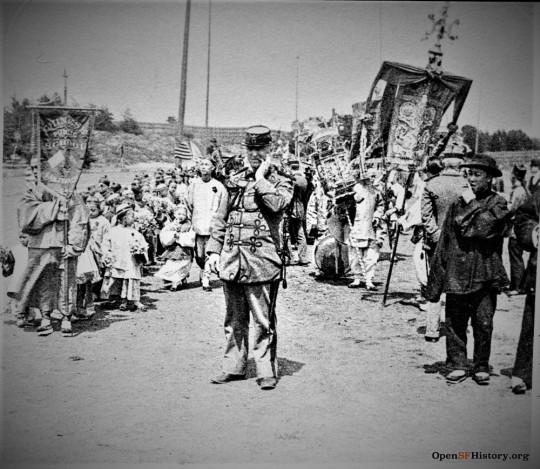
"9605. Chinese Children, Midwinter Exposition” 1894. From the Jas. A. Davis Kilburn catalog. Photograph by B.W. Kilburn (from the Marilyn Blaisdell Collection). Children from the Chinese Public School prepare to march in the China Day parade at the Midwinter Fair.
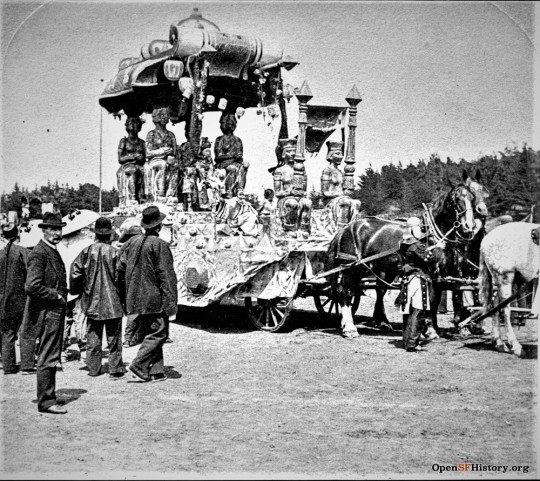
Chinese parade float pulled by a team of horses at the Midwinter Fair of 1894 in Golden Gate Park. Published in the Jas. A. Davis Kilburn catalog: "9615 Sacred Gods of China. Arranged on a float for the inspection of visitors." Photograph by B.W. Kilburn (from the Marilyn Blaisdell Collection).
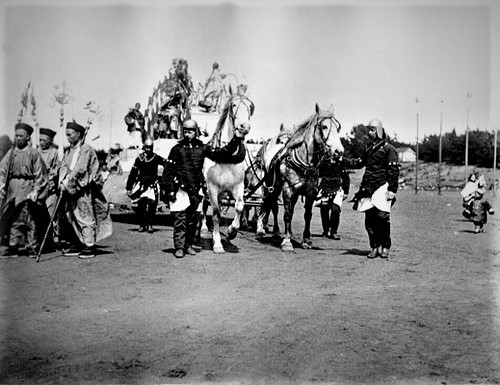
China Day parade at the 1894 Midwinter Fair.


Boys and banners float for Chinese parade on Recreation Field (Big Rec) for the Midwinter Fair, June 1894. Photographer Unknown (from the Wyland Stanley Collection).
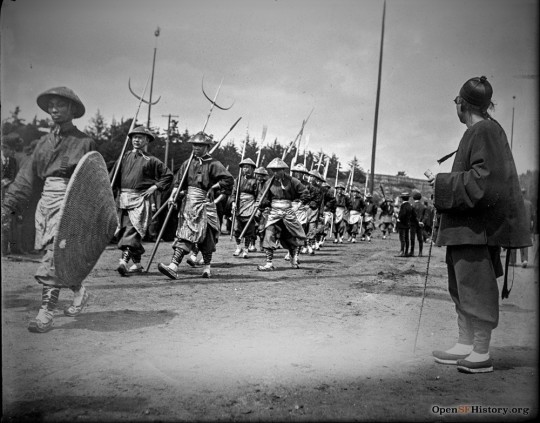
Marching men in costume/uniform with shield and tridents at the Midwinter Fair of 1894. Photographer unknown (from the Wyland Stanley Collection).
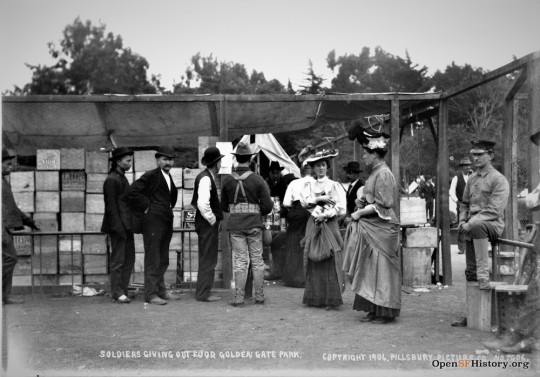
“Soldiers Giving Out Food, Golden Gate Park,” 1906. Pillsbury Picture Co. No. 7606, Pillsbury Picture Co. (from a private collection). Two Chinese men join a relief line overseen by federal trooper. Such proximity to whites in Golden Gate Park would not last long, as the Army would relocate the Chinese to the Presidio encampments after white protests.

Earthquake refugees being fed in the park, May 1906 Photographer Unknown (courtesy of a private collector). Some of the diners appear to wear Chinese dress of that era, but their presence cannot be ascertained definitively.
The presence of Chinese earthquake refugees in Golden Gate Park was short-lived. White refugees and neighbors demanded that the US Army move the Chinese refugees from Golden Gate Park and the main camp at the Presidio’s golf course. The Army complied and moved the Chinese to Fort Winfield Scott.
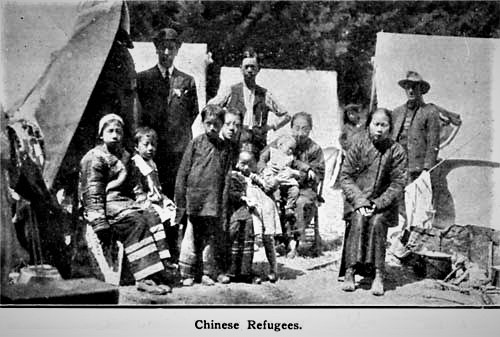
“Chinese Refugees” c. April 1906. Photographer unknown
The photographic record of Chinese community patronage of Golden Gate Park remains scant, even in the hundreds of photo taken of the mass refugee evacuation and temporary resettlement to the park in the aftermath of the 1906 quake and fire. Military inspection reports indicate that the Army provided for the Chinese and all of the other refugees in the Presidio. However, the Chinese are largely absent from the contemporary photos taken of the bread lines, the large tent encampments, and other refugee sites in Golden Gate Park. Segregation of the community prevailed even in the midst of disaster.
Research continues.
#Chinese visitors to Golden Gate Park#1894 Midwinter Fair#Midwinter Faire of 1894#Chinese Public School#Chinese refugees of 1906#Isaiah West Taber#B.W. Kilburn
0 notes
Photo

Side view of Detroit City Hall with Pontchartrain Hotel and Hammond building in background. Pedestrians, streetcars and horse-drawn vehicles in street. Printed on front: "City Hall, Pontchartrain Hotel and Hammond building, Detroit, Mich." Printed on back: "1411, City Hall, Pontchartrain Hotel and Hammond Bldg. This handsome group of buildings is situated in the heart of the business section of Detroit and it goes with saying that they are a credit to this already distinguished city." Handwritten on back in upper right corner: "7/15/12."
Courtesy of the Burton Historical Collection, Detroit Public Library
#detroit#detroit city hall#pontchartrain hotel#hammond building#hammond#pontchartrain#detroit history#postcard#postcards#1912#vintage postcards#city hall#detroit buildings#detroit architecture#architecture#buildings#downtown#downtown detroit#detroit public library
31 notes
·
View notes